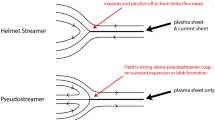Abstract
Nose structures are objects formed by H+ particles penetrating into the inner magnetosphere [1, 2]. We present the results of experimental studies and numerical modeling of the nose structures. Statistical processing of the observations of nose structures in 1997 by the ION instrument onboard the Interball-2 satellite at heights of 10 000–15 000 km demonstrates that the probability of formation of the nose structures under quiet magnetic conditions (with current values K p = 0–1) in the nighttime sector of the magnetosphere is ∼90%. The probability of observation of the nose structures in the daytime sector equals ∼ 50% at the current value K p = 0–1, and the correlation between the observations of nose structures and K p can be improved (up to ∼ 75%) if the K p index is taken 6 h before the observed events. It is shown that nose structures are a characteristic feature not only of the substorm processes but also of quasi-stationary phenomena in the quiet magnetosphere. The nose structures observed in magnetically quiet periods are called stationary nose structures in this work. By modeling drift trajectories for protons, it is shown that the stationary nose structures are formed in all sectors of the MLT. The stationary nose structures observed by the ION instrument are modeled in the night, morning, and daytime sectors of the MLT. The relation between the stationary nose structures and ion spectral gaps is considered.
Similar content being viewed by others
REFERENCES
Smith, P.H. and Hoffman, R.A., Direct Observations in the Dusk Hours of the Characteristics of the Storm Time Ring Current Particles during the Beginning of Magnetic Storms, J. Geophys. Res., 1974, vol. 79, p. 966.
Ejiri, M., Hoffman, R.A., and Smith, P.H., Energetic Particle Penetrations into the Inner Magnetosphere, J. Geophys. Res., 1980, vol. 85, p. 653.
Ejiri, M., Trajectory Traces of Charged Particles in the Magnetosphere, J. Geophys. Res., 1978, vol. 83, p. 4798.
Konradi, A., Semar, C.L., and Fritz, T.A., Substorm-Injected Protons and Electrons and the Injection Boundary Model, J. Geophys. Res., 1975, vol. 80, p. 543.
Ganushkina, N.Yu., Pulkkinen, T.I., Sergeev, V.A., et al., Entry of Plasma Sheet Particles into the Inner Magnetosphere as Observed by Polar/CAMMICE, J. Geophys. Res., 2000, vol. 105, p. 25205.
Shirai, H., Maezawa, K., Fujimoto, M., et al., Monoenergetic Ion Drop-off in the Inner Magnetosphere, J. Geophys. Res., 1997, vol. 102, p. 19873.
McIlwain, C.E., Plasma Convection in the Vicinity of the Geosynchronous Orbit, in Earth's Magnetospheric Processes, McCormac, B.M., Ed., Norwell, Mass.: D. Reidel, 1972, p. 268.
Buzulukova, N.Yu., Ion Spectral Gaps as a Method for Checking the Existence of Quiet-Time Stationary Large-Scale Convection, Its Models, and Particle Source Localization in the Inner Magnetosphere: ION Spectrometer Observations on the Interball-2 Satellite, Kosm. Issled., vol. 38, no. 5, pp. 524–535.
Buzulukova, N.Yu., Galperin, Yu.I., Kovrazhkin, R.A., et al., Two Types of Ion Spectral Gaps in the Quiet Inner Magnetosphere: INTERBALL-2 Observations and Modelling, Ann. Geophys., 2002, vol. 20, p. 349.
Galeev, A.A., Galperin, Yu.I., and Zelenyi, L.M., The INTERBALL Project to Study Solar—Terrestrial Physics, Kosm. Issled., 1996, vol. 34, no. 4, pp. 339–362.
Sauvaud, J.-.A., Barthe, A., Aoustin, A., et al., Measurement of the Suprathermal Plasma by the ION Spectrometric Complex on the INTERBALL-2 Satellite (Auroral Probe), Kosm. Issled., 1998, vol. 36, no. 1, pp. 63–72.
Sauvaud, J.-A., Barthe, H., Aoustin, C., et al., The ION Experiment onboard the INTERBALL-Auroral Satellite; Initial Results on Velocity-Dispersed Structures in the Cleft and inside the Auroral Oval, Ann. Geophys., 1998, vol. 16, p. 1056.
Kovrazhkin, R.A., Sauvaud, J.-A., and Delcourt, D.C., INTERBALL-Auroral Observations of 0.1–12 keV Ion Gaps in the Diffuse Auroral Zone, Ann. Geophys., 1999, vol. 17, p. 734.
McIlwain, C.E., A Kp-Dependent Equatorial Electric Field Model, Adv. Space Res., 1986, vol. 6, p. 187.
Volland, H., A Semiempirical Model of the Large-Scale Magnetospheric Electric Fields, J. Geophys. Res., 1973, vol. 78, p. 171.
Stern, D.P., The Motion of a Proton in the Equatorial Magnetosphere, J. Geophys. Res., 1975, vol. 80, p. 595.
Ganushkina, N.Yu., Pulkkinen, T.I., Bashkirov, V.F., et al., Formation of Intense Nose Structures, Geophys. Res. Lett., 2001, vol. 28, p. 491.
Author information
Authors and Affiliations
Rights and permissions
About this article
Cite this article
Buzulukova, N.Y., Kovrazhkin, R.A., Glazunov, A.L. et al. Stationary Nose Structures of Protons in the Inner Magnetosphere: Observations by the ION Instrument onboard the Interball-2 Satellite and Modeling. Cosmic Research 41, 3–12 (2003). https://doi.org/10.1023/A:1022343327565
Issue Date:
DOI: https://doi.org/10.1023/A:1022343327565




